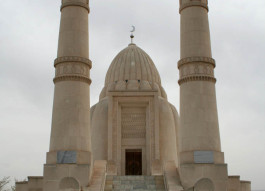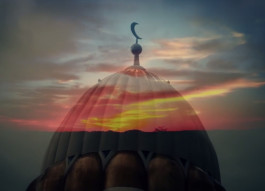 Holy places
Holy places
42.888, 69.9874
Domalak Ana Mausoleum is a unique architectural monument of the South Kazakhstan. The monument is located in the South-Kazakhstan region, on the southern slope of Karatau, on the valley of Balabogen.
The mausoleum was built over the grave of Ali Nurily Sylankyzy, who is known as Domalak Ana.
Domalak Ana is one of the legendary mothers of Kazakhs. Domalak ana was a third wife of the hero Baidibek Karashauly, who managed the tribes, inhabiting the Seven Rivers, and the mother of Alban, Suan, and Dulat. She was modest, loving mother, who shared her love to all children of clairvoyant. She could foresee the future. People called her "Domalak ana", "Domalak ana", because she was small. According to another version, Domalak Ana comes from the Persian "Dihnat mom", which means Holy Mother. Subsequently, the word Dihnat has changed into Domalak.
She became famous among people by her intelligence, wisdom, purity, and sanctity of soul. There are a few stories about her resourcefulness and wisdom. Domalak Ana reconciled and drowned eternal resentment by her wise decisions. Domalak Ana is the mother of people, who are living in the Seven River, Aulie-Ata, Shymkent, and Tashkent. Her son Zharykshak was an adviser at the Tashkent Amir, later governor of the Zheti-su, then the chief vizier of Esenbuga Khan.
There are many stories and legends about that woman. Some of them correspond with facts about life and close to the truth.
Very popular legend is about the prophecy that she made for her husband Baidibek Karashauly: "Once upon enemies suddenly attacked to the Baidibek’s village, which is located on Karatau ridge, and stole thousands of horses. At that time Baydibek and other men were away from the village. After hearing the news about the attack, Badibek assembled a squad and with six sons from the eldest wife - Sarah baybishe went in pursuit. Only one wild horse came back to the village from thousands of stolen horses.
When Baydibek stood near the yurt of Domalak Ana, she turned to him and said: "Do not follow the enemy. Bay stallion stayed with us. After six days, the herd will return to you. Let zhigits (men) be alive, that is my desire". But, the warrior did not hear his wife and hit the road. After catching enemies at the pass Kuyuk, there was a battle among them. Well-armed enemies defeated a small army of Baidibek. Six sons died in that battle. He returned home after burying them in the valley of Ushkarasay. Six days later, a huge herd of horses back home".
Domalak Ana was buried in the plain of the river Kos Bogen. Grateful descendants established a mausoleum at this place. According to legends, there are two sacred stones in the Domalak Ana mausoleum, and only religious man can pass between them.
Mausoleum Domalak Ana was built in 1456 as a four-wall Mazar with domes. The construction was rebuilt several times. Unfortunately, original appearance has not been preserved until the present day.
A new building was erected on the place of ruined buildings in the late 19th - early 20th century, where preserved only an old masonry of square bricks. Outside and inside the Mazar was plastered and whitewashed. A small brick building presented rotunda - a cylindrical volume, which was decorated on the facade with 6 niches. There was entrance aperture in the south.
Wide blades, pilasters relied on a low base and supported by three overhanging ledges band cornice, delaminating dome. There was not an interior decor element. The inscription was in the Kazakh language, which made on the wall at the entrance of Mazar, reported: "A monument in honor of the Great Mother Babizhar, daughter of Aksultan". A quatrain is below, which called to commemorate mothers.
There was the modern look of a mausoleum after general reconstruction, which was held by the architect S. Toktamys in 1996. During the work was made a clutch of white stone, which was brought from Mangistau. The height of the Domalak Ana mausoleum is 12 meters, eight sleeved dome is located in the main building.
Today Domalak Ana mausoleum is one of the main attractions of the South Kazakhstan region and is very popular among tourists and pilgrims, who are desired to worship to great Kazakh mother.
Arystan Bab Mausoleum is a mausoleum in Kazakhstan close to the village of Kogam and Otrartobe.

The Aisha-Bibi is in the west of Taraz, Kazakhstan on the Silk Road. It is locally famous as a monument to love and faithfulness.
The religious structure continues to draw pilgrims from across Central Asia and has come to epitomize the Kazakh national identity.
Baydibek Karashauly (dates of birth and death are unknown) lived in the 11-12th centuries in the neighborhood of East Karatau, died in present Algabas district, near Aktas stud and buried on the river bank of Balabogen. The tomb established still in the ancient time with a dome remained.

Beket-Ata Underground mosque is located in the Oglandy countryside, Mangystau region. This religious monument of architecture dates back to the XVIII century. Beket-Ata is considered as a holy place, in importance as a burial of Khozha Ahmed Yassaui. During two centuries, pilgrims come here for bowing the Holy Spirit.

Everything that is known of this cave, is similar both on true and false at the same time. Local people say that there are three caves called Konyr-Auliye ("auliye" – sacred, the Saint) in Kazakhstan.




























